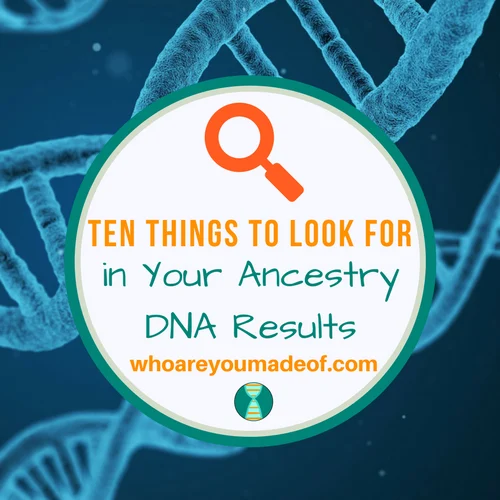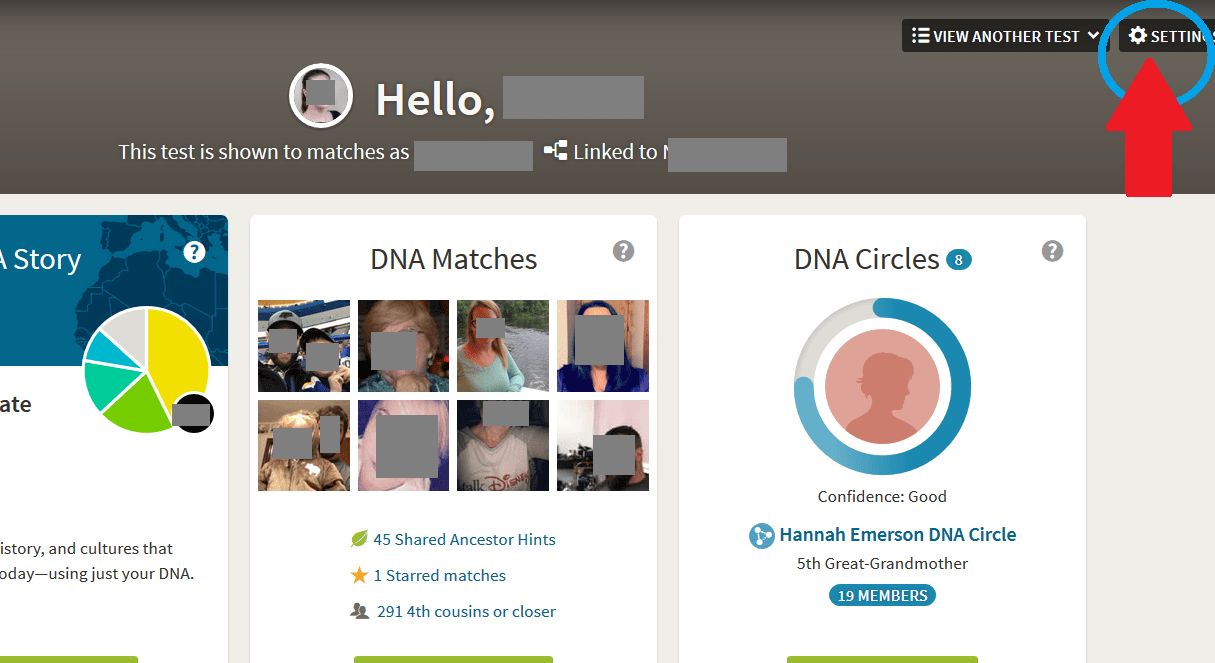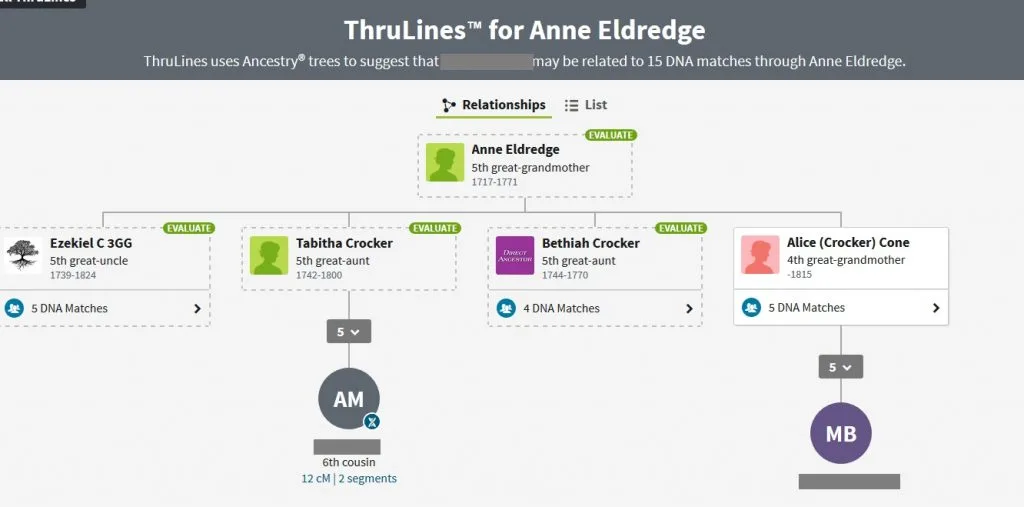In this post, I am going to tell you ten things to look for in your Ancestry DNA results. Once you've read through this list, you'll have a good idea of what to do next.
Did you just receive your Ancestry DNA results? Many people "do their DNA" looking for some insight into their family's ethnic heritage, and are satisfied after a glance at their ethnicity estimate.

If that's all you wanted from the experience, that is totally cool. Many people find themselves curious about their results, and wonder what their Ancestry DNA report is really telling them.
If you want to get the most from your results, however, keep reading this post!
There is SO much you can do now that you've done your Ancestry DNA. This just might be the beginning of a really cool learning adventure.
Have you attached a family tree to your results?
If you attach a family tree (even a small one) to your DNA results, you can get access to extra features. For example, if your tree is attached, you will be able to see ThruLines (more on this below), surnames in common in your tree when you view a DNA match.
Plus, if you attach your DNA results to your family tree, Ancestry will be able to tell you which common ancestor you share with your DNA matches that also have family trees attached to their results.
How neat is that? Plus, it saves a lot of time and work.
Read my post: How to attach a family tree to your Ancestry DNA Results for more info.
Do you know how to access your test settings on Ancestry?
One of the first things you should know about your Ancestry DNA results is that there are many settings that you can change on your account. In the image below, you can see where you need to click on your screen (from the DNA Insights page) to access your test settings:

Did you know your test results came with DNA matches, too?
You would be surprised at how many people have no idea that their Ancestry DNA test results come with a huge list of DNA matches. A list of actual living, breathing, relatives.
They are listed in the order of closest relatives to most distant. You should definitely consider taking a peek at your list, you never know who you might find.
I first realized that people don't always know that they have DNA matches on their DNA results when I was talking to a friend who mentioned that there is a family rumor that her dad had had a daughter when he was stationed overseas.
She asked me if she would need to do another DNA test in order to start looking for her, and was so happy and surprised to know that all she would have to do was click on a different button on her Ancestry DNA results.
It was like a free bonus for her!
Who are your closest matches on Ancestry DNA?
Your DNA matches are organized into categories. The top category is a Parent/Child match, then Immediate Family, where siblings are usually placed.
The following categories are Close Family, 1st, 2nd and 3rd Cousins. The next category is 4th Cousin, and the last is Distant Cousin.
How much DNA do you share with your DNA match on Ancestry?
You can actually see a lot of information about your DNA matches on Ancestry. Just click on any given DNA match - maybe your top match - and check out their match profile.
You'll see a list of their ethnicities (on the top right of the screen), the estimated relationship that you have with them, and whether or not they have a family tree.
Once you know how much DNA that you share, you can read the following post to learn how to use this information to determine how you might be related:
Shared DNA, along with their family tree information included on their profile, can help give you important clues about your relationship. Plus, it might help you learn something new about your ancestors.
Did you know you will get new DNA matches?
When I first wrote this post, I had only 94 DNA matches that were likely related to me at a 4th cousin level or closer. As of today (Jan 2023), I have 835.
In January of 2022, I had 776 matches related at an estimated 4th cousin distance or closer. In January of 2021, I had 656.
As you might notice, I have gotten more than 100 relatively close matches each year for the past couple of years. This is not counting the thousands of more distant cousins that have taken Ancestry tests and show up as matches for me - I have more than 20,000 total DNA matches, and that number grows each year.
This is very exciting, since learning how I am related to these new matches can help me discover more about my family tree.
There is a lot that I can learn from my matches, and so I am glad to get new matches on an almost weekly basis. Make sure you check your results every once in a while to see if you have new matches, too!
Do you have any ThruLines?
ThruLines is a really useful feature used to help you figure out how you are related to your DNA matches and identify potential ancestors that you might not know about yet.
In order to get Ancestry ThruLines, you will need to make sure that you have a family tree and that it is attached to your DNA results. Your tree also has to be "searchable" (you can make sure that it is in your tree settings).
Within a few days, you will be able to find out whether Ancestry has been able to use the power of its immense database of DNA results and family trees to identify DNA matches that are descended from ancestors included in your tree.
Below, you can see an example of one of my ThruLines. My ancestor is at the top (Anne). She had three kids, but I had only one of them added to my tree (Alice).
I can see her other potential (and likely) children outlined with the dotted line. Below their names, I can see that I have several DNA matches descended from each of those individuals.

If I want to, I can add all of those people to my family tree and get in touch with them.
What's that I hear? You haven't built a family tree yet? You definitely aren't alone, there are many people who have tested their DNA that don't have a family tree, or who have not attached it to their results.
Building a family tree is a really amazing experience, however, and you will get so much more from your DNA results if you decide to give it a shot.
Learn how to filter and sort your DNA matches
There are some nice ways to filter and organize your DNA matches. This is a great way to learn new information about your matches.
One thing you can do is filter your results so that way you can see only DNA matches that Ancestry DNA has identified to be common ancestor to you. Or, you can view your DNA matches by parent to learn who your paternal and maternal matches are.
Alternatively, you can sort your matches to show people who share a specific amount of DNA with you. This is helpful if you want to focus on cousins of a certain relationship distance.
You could also filter out all of your DNA matches who don't have family trees attached to their results. This is a great way to quickly find DNA matches that you might be able to spot your connection with.
There are countless more ways to filter and sort. What will you learn?
Have you tried a surname search in your DNA match list?
Another really helpful tool to try to figure out how your DNA matches are related to you is to do a surname search in your Ancestry DNA match list. The surname search looks for people who have the surname that you enter in their family tree (not people who currently have that surname as their own).
To search your matches, just click the search link at the top of your DNA match list on the right side. A new menu will expand and you will be able to search your matches.
You can search for their actual name, a name included in their family tree, or birth locations in their family tree.

This feature works best if you are searching for a relatively uncommon name. Obviously, if you are looking for Smiths, there is a good chance that there are hundreds of people who have the Smith surname in their tree, but they are not your Smiths (some of them will be, but it will take some work to figure out which ones are and which ones aren't!).
The same is true for birth location. For example, lots of people have been born in Newark, NJ. The same is not true for Kasbeer, Illinois.
Conclusion
I hope that this post helped orient you with your DNA results and gave you some ideas about what to look for in your own unique DNA.
If you have anything to add, or would like to share your own experience with your Ancestry DNA test, I would love to hear from you in the comments.
Thanks for stopping by!

